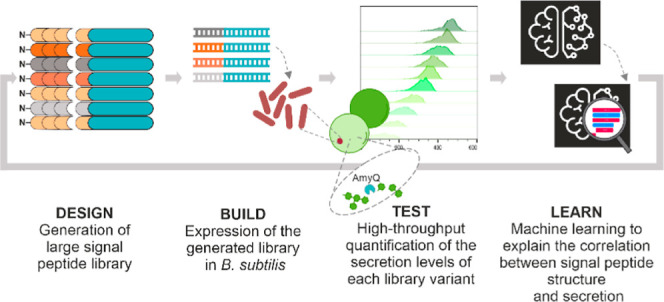Applications & Publications
Publications
Signal Peptide Efficiency: From High-Throughput Data to Prediction and Explanation
Grasso et al. January 27, 2023 ACS Synth Biol. 2023 Feb 17; 12(2): 390–404. Published online 2023 Jan 17. doi: 10.1021/acssynbio.2c00328
View AbstractSignal Peptide Efficiency: From High-Throughput Data to Prediction and Explanation

The passage of proteins across biological membranes via the general secretory (Sec) pathway is a universally conserved process with critical functions in cell physiology and important industrial applications. Proteins are directed into the Sec pathway by a signal peptide at their N-terminus. Estimating the impact of physicochemical signal peptide features on protein secretion levels has not been achieved so far, partially due to the extreme sequence variability of signal peptides. To elucidate relevant features of the signal peptide sequence that influence secretion efficiency, an evaluation of ∼12,000 different designed signal peptides was performed using a novel miniaturized high-throughput assay. The results were used to train a machine learning model, and a post-hoc explanation of the model is provided. By describing each signal peptide with a selection of 156 physicochemical features, it is now possible to both quantify feature importance and predict the protein secretion levels directed by each signal peptide. Our analyses allow the detection and explanation of the relevant signal peptide features influencing the efficiency of protein secretion, generating a versatile tool for the de novo design and in silico evaluation of signal peptides.
Stable and selective permeable hydrogel microcapsules for high-throughput cell cultivation and enzymatic analysis
Girolamo et al. August 27, 2020 Microb Cell Fact. 2020; 19: 170. Published online 2020 Aug 27. doi: 10.1186/s12934-020-01427-9
View AbstractStable and selective permeable hydrogel microcapsules for high-throughput cell cultivation and enzymatic analysis
A new microbial gluten-degrading prolyl endopeptidase: Potential application in celiac disease to reduce gluten immunogenic peptides
Amador et al. June 27, 2019 PLoS One. 2019; 14(6): e0218346. Published online 2019 Jun 27. doi: 10.1371/journal.pone.0218346
View AbstractA new microbial gluten-degrading prolyl endopeptidase: Potential application in celiac disease to reduce gluten immunogenic peptides
Identification and Characterisation of a pH-stable GFP
Tania M. Roberts, Fabian Rudolf, Andreas Meyer, Rene Pellaux, Ellis Whitehead, Sven Panke, and Martin Held June 21, 2016 Scientific Reports, (2016) London: Nature Publishing Group.
Identification and Characterisation of a pH-stable GFP
Optimization of a whole-cell biocatalyst by employing genetically encoded product sensors inside nanolitre reactors
Andreas Meyer¹,², René Pellaux¹,², Sébastien Potot³, Katja Becker¹, Hans-Peter Hohmann³, Sven Panke¹ & Martin Held¹ July 13, 2015 Nature Chemistry 7, 673–678 (2015) doi:10.1038/nchem.2301
View AbstractOptimization of a whole-cell biocatalyst by employing genetically encoded product sensors inside nanolitre reactors
1Department of Biosystems Science and Engineering, ETH Zurich, Basel 4058,
2FGen GmbH, Basel 4057, Switzerland
3DSM Nutritional Products, Kaiseraugst 4303, Switzerland
Flow cytometry of microencapsulated colonies for genetics analysis of filamentous fungi
Lidia Delgado-Ramos,*,†, ¹ Ana T. Marcos,*,¹ María S. Ramos-Guelfo,* Leyre Sánchez- Barrionuevo,*, Francis Smet,§, Sebastián Chávez,*, †,² and David Cánovas *,² September 19, 2014 G3: Genes|Genomes|Genetics Early Online, published on September 19, 2014 as doi:10.1534/g3.114.014357
View AbstractFlow cytometry of microencapsulated colonies for genetics analysis of filamentous fungi
*Departamento de Genética, Universidad de Sevilla, Seville, Spain
†Instituto de Biomedicina de Sevilla (IBiS), Hospital Universitario Virgen del Rocío-CSIC9 Universidad de Sevilla, Seville, Spain
§Union Biometrica, Geel, Belgium
1These authors have equally contributed to this work and their names are written in alphabetical order.
2Corresponding authors
Flow-based pipeline for systematic modulation and analysis of 3D tumor microenvironments.
Li CY, Wood DK, Huang JH, Bhatia SN.
Chemical Engineering, Massachusetts Institute of Technology, Cambridge, Massachusetts 02139, United States.
April 23, 2013
Lab Chip. 2013 Apr 23;13(10):1969-78. doi: 10.1039/c3lc41300d. Epub 2013 Apr 5.
Flow-based pipeline for systematic modulation and analysis of 3D tumor microenvironments.
A new method for fungal genetics: flow cytometry of microencapsulated filamentous microcolonies
27th Fungal Genetics Conference
Lidia Delgado-Ramos¹, Ana T. Marcos¹, Xenia Peñate¹, María S. Ramos-Guelfo¹, Leyre Sánchez-Barrionuevo¹, Francis Smet²,
David Cánovas¹ and Sebastián Chávez¹
March 12, 2013
A new method for fungal genetics: flow cytometry of microencapsulated filamentous microcolonies
1) Departamento de Genética, Universidad de Sevilla, Spain. 2) Union Biometrica, Geel, Belgium
For more information on Cellena® which can be utilized in combination with our COPAS and BioSorter products see: www.cellena.net/en/news.html
